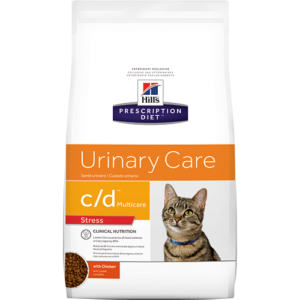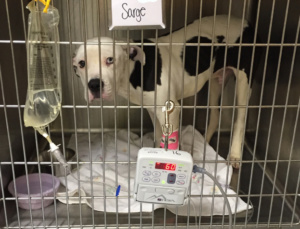As a high volume general practitioner and emergency veterinarian, we see different problems at our office ranging from minor injuries to life threatening emergencies. At least half of our clients are either rescues or individuals experiencing financial difficulties, and because of that we see many cases where patients have been treated at home in an attempt to save money, which in the long run ends up being more costly. From searching Dr. Google to posting for advice on social media to treating animals like ‘little people’, sometimes avoiding an early trip to the vet or using alternative products can be costly and even dangerous for our pets. Here are a few examples of some of the problems we see at our practice.

Hill’s C/D feline is a prescription diet that dissolves crystals and helps with stones and cystitis in cats.
1. Blocked cats: Male cats can develop a condition in which their urethra is ‘clogged’ with a mixture of mucus and crystals. As a result they cannot pass urine and the body quickly becomes sick from the inability to eliminate waste from the body. Many pet owners confuse this problem with constipation, since what they see is their cat’s unproductive straining in the litter box. Because of this, some pet owners look for home remedies or pet store products for constipation and treat their very sick cat for a problem they do not have. By the time they are brought in to the hospital, their kidneys are failing, they have life threatening electrolyte imbalances, and often have heart rhythm abnormalities. Treatment consists of removing the obstruction and in some cases surgery. After surgery, they must be kept on a prescription diet (i.e. Hill’s C/D) to decrease the risk of crystal build up in the urine. Here is where we see a big problem. Because prescription diets are more costly than commercial diets, pet owners often switch to diets that say ‘urinary health’. However, these are not adequate for cats that have these problems and we often see them come back for recurrence of the obstruction. Yes, these diets are more expensive but realize that they are a form of medication. Instead of giving food and a ‘pill’, the ‘pill’ is in the food. I think most cat owners would agree that giving a medicated food beats the stress (and scratches) that result from trying to pill a cat.

Fleas are both a pest and a vector for other diseases.
2. Fleas: Veterinary approved flea control products, both topical and oral, are tested to be safe and effective when administered properly and year-round. Over the counter products do not need to be safe to our pets or effective against fleas, they just have to pass EPA requirements for being environmentally safe. For this reason, over the counter products can be at best ineffective and at worst dangerous to dogs and especially cats. Even cat-labelled products can be toxic and result in seizures. Baths do not provide long term protection. Garlic is toxic (see previous article on garlic). Fleas are not just a pest. They cause allergies and skin infections and can transmit diseases. Waiting to get your pet adequate flea prevention can cost money in controlling the infection, swelling, hair loss, and pain that can result from flea allergies. Good flea products are more expensive, but in the end save money in veterinary appointments and medications, not to mention saving your pet from the pain and discomfort of fleas and the infections the cause.

Dropped ear flap and a head tilt can be signs of an ear infection.
3. Ear infection: A common problem for dogs, ear infections are usually a result of allergies, skin disease, or excess water in the ear canal. Many pet owners come in after they have been treating their dog for ear mites and the problem doesn’t get better. Ear mites are rare in dogs and the most common infection type is yeast. Those who ‘google’ ear infection remedies, find all sorts of mixes from half vinegar (5-20% acetic acid) to using antiseptic oral rinse (i.e. Listerine) in the ear. Can you imagine the burn and pain that results from this? In addition to not being effective, it can cause problems due to irritation, swelling, and damage to the ear drum including rupture. And taking care of the ear infection alone doesn’t really fix the problem since they are often a symptom of another condition. Proper examination, evaluation of the cause, and adequate topical and oral treatment is the best way to get the problem under control long term.

Mosquitoes transmit heartworm disease, so even indoor only pets are at risk.
4. Heartworm prevention: Some people tell their friends on social media to use large animal products to prevent heartworm disease. This can be very dangerous to our pets. First, if you give a medication that can kill the heartworm larva to a positive dog, it can cause a deadly allergic reaction. These products are also very concentrated and can result in neurologic (seizures) and gastrointestinal disease. There are also some ‘natural’ websites recommending testing and intermittent prevention instead of year-round prevention. If prevention is not given at proper intervals, an infected pet will develop heartworm disease. Heartworm prevention prescribed by your veterinarian is the safest way and, in many cases can be very inexpensive, definitely less expensive than treatment (see previous article “Heartworm Disease: Can You Afford Not to Prevent it”.

Quick and aggressive treatment is the best way to increase the chance of recovery from Parvovirus.
5. Parvovirus: Saved the biggest one for last. Parvovirus is a deadly disease that causes vomiting, diarrhea, dehydration, and generalized infection (sepsis). This disease can be prevented or at least reduced in severity with proper vaccination. Because dogs do not have to come in direct contact with sick dogs to become exposed, the only way to protect your pet is to vaccinate properly and keep them away from high risk areas. We will discuss prevention and treatment separately as we will often see issues with both.
a. Prevention: When trying to save money, pet owners will seek online pharmacies or local feed stores in order to purchase vaccines they can give to their pets at home. Sadly, many of the dogs we hospitalize at our facility have been vaccinated by their owners. Why don’t these vaccines work? The answer is one of many possibilities: the quality of the vaccine, the storage at the facility or during transit, the handling/mixing of the vaccine vials, the administration of the injection, and finally booster intervals. Problems with any of these can cause a vaccine to be ineffective. As a result, you pay $5 for a vaccine that costs you a $600-1,500 parvovirus treatment bill and possibly a dead dog from parvovirus. With low-cost vaccine clinics as alternatives, where good quality vaccines are administered by licensed veterinarians and their staff, it is not worth taking the risk of a sick pet over a few dollars.
b. Treatment: When a dog is suspected of having parvo, many seek ways to treat them at home. Things like pedialyte and bland diets are often used. The problem with this disease is that the vomiting and diarrhea do not allow for proper hydration without IV fluids, and antibiotic therapy usually has to be done with IVs as well since they can’t keep anything down. Also, the pet is shedding large amounts of virus into the home environment. With quick action and aggressive hospitalization and treatment, pets can have as high as an 80% chance of survival. Veterinary prescribed at-home care, done when a pet owner refuses hospitalization, is much less expensive, but if the patient is too sick it may have less than a 35% success rate. Trying at-home care first and if it doesn’t work hospitalizing them decreases their chances for survival and increases their overall hospital stay and as such the expense.
If you want to be informed about pet conditions from a good pet owner resource written by veterinarians, we recommend www.veterinarypartner.com.
If you would like to submit a topic or specific question you would like for Dr. G to address in this blog, let us know by sending an email with Rascal’s Corner in the subject line.
Email to askDrG@generationwags.com
To view all posts in Rascal’s Corner click here!


